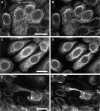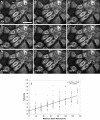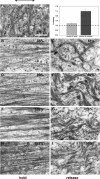The intermediate filament network in cultured human keratinocytes is remarkably extensible and resilient
- PMID: 18523546
- PMCID: PMC2390850
- DOI: 10.1371/journal.pone.0002327
The intermediate filament network in cultured human keratinocytes is remarkably extensible and resilient
Abstract
The prevailing model of the mechanical function of intermediate filaments in cells assumes that these 10 nm diameter filaments make up networks that behave as entropic gels, with individual intermediate filaments never experiencing direct loading in tension. However, recent work has shown that single intermediate filaments and bundles are remarkably extensible and elastic in vitro, and therefore well-suited to bearing tensional loads. Here we tested the hypothesis that the intermediate filament network in keratinocytes is extensible and elastic as predicted by the available in vitro data. To do this, we monitored the morphology of fluorescently-tagged intermediate filament networks in cultured human keratinocytes as they were subjected to uniaxial cell strains as high as 133%. We found that keratinocytes not only survived these high strains, but their intermediate filament networks sustained only minor damage at cell strains as high as 100%. Electron microscopy of stretched cells suggests that intermediate filaments are straightened at high cell strains, and therefore likely to be loaded in tension. Furthermore, the buckling behavior of intermediate filament bundles in cells after stretching is consistent with the emerging view that intermediate filaments are far less stiff than the two other major cytoskeletal components F-actin and microtubules. These insights into the mechanical behavior of keratinocytes and the cytokeratin network provide important baseline information for current attempts to understand the biophysical basis of genetic diseases caused by mutations in intermediate filament genes.
Conflict of interest statement
Figures






References
-
- Coulombe PA, Wong P. Cytoplasmic intermediate filaments revealed as dynamic and multipurpose scaffolds. Nature Cell Biology. 2004;6:699–706. - PubMed
-
- Fraser RD, MacRae TP, Rogers GE. Keratins: Their Composition, Structure, and Biosynthesis. In: Kugelmass IN, editor. Springfield, IL: Charles C. Thomas; 1972. p. 304.
-
- Baribault H, Price J, Miyai K, Oshima RG. Mid-gestational lethality in mice lacking keratin 8. Genes Dev. 1993;7:1191–1202. - PubMed

